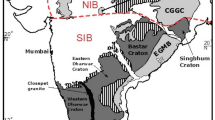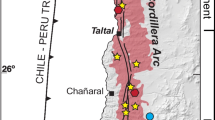Abstract
The Karakorum Fault zone (KFZ) plays an important role in understanding the formation, evolvement and deformation of the Tibetan Plateau. The high-T dextral shearing metamorphic rocks, e.g., mylonites or mylonitized gneisses-granites, locally crop out along the southeastern part of the KFZ in the Ayila Ri’gyü Range area. The SHRIMP U-Pb dating of the syn-kinematic crystallized zircons indicates that the initial age of the KFZ is ∼27 Ma, ∼10 Ma older than previous results. The extensive high-T dextral shearing along the KFZ started at least at 27–20 Ma, accompanied by the syn-kinematic emplacement of leuco-granites. Deformation and concomitant fluid circulation during shearing most likely occurred as early as at 25–13 Ma. The KFZ probably grew from southeast to northwest along the fault as a result of continuous convergence between the India plate and Eurasia plate.
Similar content being viewed by others
References
Avouac J P, Tapponnier P. Kinematic model of active deformation in central Asia. Geophys Res Lett, 1993, 20(10): 895–898
Wright T J, Parsons B, England P C, et al. InSAR observations of low slip rates on the major faults of Western Tibet. Science, 2004, 305:236–239
Matte P, Tapponnier P, Arnaud N, et al. Tectonics of Western Tibet, between the Tarim and the Indus. Earth Planet Sci Lett, 1996, 142:311–330
Searle M P, Weinberg R F, Dunlap W J. Transpressional tectonics along the Karakoram fault zone, northern Ladakh: constraints on Tibetan extrusion. In: Holdsworth R E, Strachan R A, Dewey J F, eds. Continental Transpressional and Transtensional Tectonics. Geol Soc London Spec Pub, 1998, 135: 307–326
Murphy M A, Yin A, Kapp P, et al. Southward propagation of the Karakoram fault system, southwest Tibet: Timing and magnitude of slip. Geology, 2000, 28: 451–454
Murphy M A, Yin A, Kapp P, et al. Structural evolution of the Gurla Mandatha detachment system, southwest Tibet: implications for the eastward extent of the Karakoram fault system. Geol Soc Am Bull, 2002, 114: 428–447
Zhou Y, Xu R H, Yan Y H, et al. Dating of the Karakorum Strike-slip Fault. Acta Geol Sin, 2001, 75(1): 10–18
Lacassin R, Valli F, Arnaud N, et al. Large-scale geometry, offset and kinematic evolution of the Karakorum fault, Tibet. Earth Planet Sci Lett, 2004, 219: 255–269
Valli F. Décrochements lithosphériques dans l’Ouest du plateau du Tibet: Geométrie, age, décalages cumulés et vitesse de glissement long-terme sur la Faille du Karakorum. PhD thesis, Université Paris 7, 2005
Phillips R J, Parrish R R, Searle M P. Age constraints on ductile deformation and long-term slip rates along the Karakoram fault zone, Ladakh. Earth Planet Sci Lett, 2004, 226: 305–319
Searle M P. Geology and Tectonics of the Karakoram Mountains, Map 2538. Chichester: John Wiley and Sons, 1991
Searle M P. Geological evidence against large-scale pre-Holocene offsets along the Karakoram fault: implications for the limited extrusion of the Tibetan Plateau. Tectonics, 1996, 15: 171–186
Zhang Q S, Li B Y, Wang F B, et al. A discussion on the uplifting of the Karakorum-Kunlun mountains and its impact on environmental changes. In: Abstracts of International Symposium on the Karakorum and Kunlun Mountains. Beijing: Geological Publishing House, 1992. 95
Yin J X, Bian Q T. Geological Map of the Karakorum Mountain-West Kunlun Mountain and Adjacent Areas (in Chinese). Beijing: Science Press, 1995
Chevalier M L, Ryerson F J, Tapponnier P, et al. Slip-rate measurements on the Karakorum fault may imply secular variations in fault motion. Science, 2005, 307: 411–414
Li Haibing, Valli F, Xu Zhiqin, et al. Deformation and tectonic evolution of the Karakorum fault, western Tibet. Geol China (in Chinese), 2006, 33(2): 239–255
Gapais D. Les Orthogneiss: Structures, mécanismes de déformation et analyse cinématique. Mem Doc CAESS, 1989, 28: 1–366
Leloup P H, Lacassin R, Tapponnier P, et al. The Ailao Shan-Red River shear zone (Yunnan, China), Tertiary transform boundary of Indochina. Tectonophysics, 1995, 251: 3–84
Simpson C, Wintsch R P. Evidence for deformation-induced K-feldspar replacement by myemekite. J Metam Geol, 1989, 7:261–275
Passchier C W, Trouw R A J. Microtectonics. Berlin: Springer-Verlag, 1996. 1–289
Tsurumi J, Hosonuma H, Kanagawa K. Strain localization due to a positive feedback of deformation and myrmekite-forming reaction in granite and aplite mylonites along the Hatagawa Shear Zone of NE Japan. J Struct Geol, 2003, 25: 557–574
Olesen N O. Plagioclase fabric development in a high-grade shear zone, Jotunheimen, Norway. Tectonophysics, 1987, 142: 291–308
Gower J W, Simpson C. Phase boundary mobility in naturally deformed, highgrade quartzofeldspathic rocks: evidence for diffusional creep. J Struct Geol, 1992, 14(3): 301–313
Leloup P H, Arnaud N, Lacassin R, et al. New constraints on the structure, thermochronology and timing of the Ailao Shan-Red River shear zone. J Geophys Res, 2001, 106(B4): 6657–6671
Song B, Zhang Y H, Wan Y S, et al. Mount making and procedure of the SHRIMP dating. Geol Rev (in Chinese), 2002, 48(suppl): 26–30
Hanchar J M, Rudnick R L. Revealing hidden structures: The application of cathodoluminescence and back-scattered electron imaging to dating zircons from lower crust xenoliths. Lithos, 1995, 36: 289–303
Rubatto D, Gebauer D. Use of cathodoluminescence for U-Pb zircon dating by ion microprobe (SHRIMP): some examples from high-pressure rocks of the Western Alps. In: Pagel M, Barbin V, Blanc P, et al, eds. Cathodoluminescence in Geosciences. Berlin: Springer-Verlag, 1998. 373–400
Gebauer D. A P-T-t-path for an (ultra?-) high-pressure ultramafic/mafic rock-association and its felsic country-rocks based on SHRIMP-dating of magmatic and metamorphic zircon domains; example: Alpe Arami (Central Swiss Alps). Am Geophys Union, 1996, 309–328
Vavra G, Gebauer D, Schmid R, et al. Multiple zircon growth and recrystallization during polyphase Late Carboniferous to Triassic metamorphism in granulites of the Ivrea Zone (Southern Alps): An ion microprobe (SRHIMP) study. Contrib Mineral Petrol, 1996, 122:337–358
Cherniak D J, Watson E B. Diffusion in Zircon. In: Hanchar J M, Hoskin P W O, eds. Zircon, Mineral Soc Am, 2003, 53: 113–143
Lee J, Williams I, Ellis D J. Pb, U and Th diffusion in natural zircon. Nature, 1997, 390: 159–163
Fraser J E, Searle M P, Parrish R R, et al. Chronology of deformation, metamorphism, and magmatism in the southern Karakoram mountains. Geol Soc Am Bull, 2001, 113(11): 1443–1455
Weinberg R F, Searle M P. The Pangong Injection Complex, Indian Karakoram: A case of pervasive granite flow through hot viscous crust. J Geol Soc London, 1998, 155: 883–891
Parrish R R, Tirrul R. U-Pb age of the Baltoro granite, northwest Himalaya, and implications for monazite U-Pb systematics. Geology, 1989, 17: 1076–1079
Schärer U, Harrison T M, Searle M P. Age, cooling history and origin of postcollisional leucogranites in the Karakoram batholith: A multi-system isotope study N. Pakistan. J Geol, 1990, 98: 233–251
Searle M P, Crawford M B, Rex A J. Field relations, geochemistry, origin and emplacement of the Baltoro granite, central Karakoram, Transactions of the Royal Society of Edinburgh. Earth Science, 1992, 83: 519–538
Mahéo G, Pêcher A, Guillot S, et al. Exhumation of Neogene gneiss dome between two oblique crustal boundaries in south Karakorum (NW, Himalaya, Pakistan). In: Whitney D L, Teyssier C, Siddoway C S, eds. Gneiss Domes in Orogeny. Geol Soc Am Spec Pap, 2004, 380:141–154
Bhutani R, Pande K, Desai N. Age of the Karakorum fault activation: 40Ar/39Ar geochronological study of Shyok suture zone in northern Ladakh, India. Curr Sci, 2003, 84: 1454–1458
Arnaud N. Apports de la thermochronologie 40Ar/39Ar sur feldspath potassique à la connaissance de la tectonique cénozoïque d’Asie. PhD Thesis, Université Clermont-Ferrand, 1992
Author information
Authors and Affiliations
Corresponding author
Additional information
Supported by the National Natural Science Foundation of China (Grant Nos. 40272096 and 40572122) and China Geological Survey (Grant No.1212010610105)
About this article
Cite this article
Li, H., Valli, F., Liu, D. et al. Initial movement of the Karakorum Fault in western Tibet: constraints from SHRIMP U-Pb dating of zircons. Chin. Sci. Bull. 52, 1089–1100 (2007). https://doi.org/10.1007/s11434-007-0164-6
Received:
Accepted:
Published:
Issue Date:
DOI: https://doi.org/10.1007/s11434-007-0164-6




